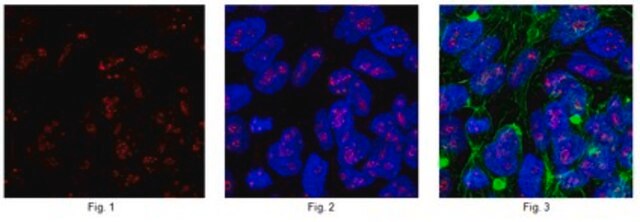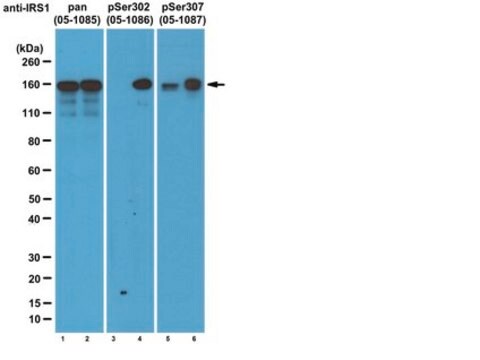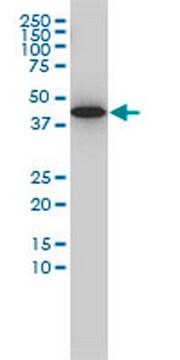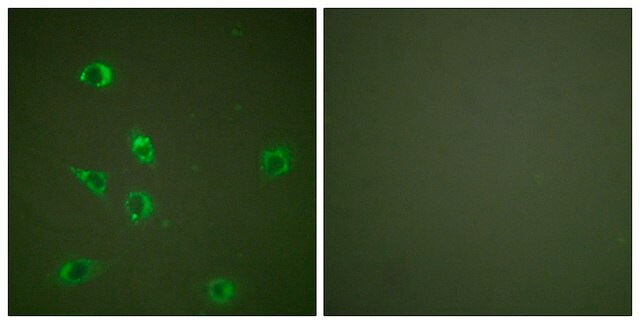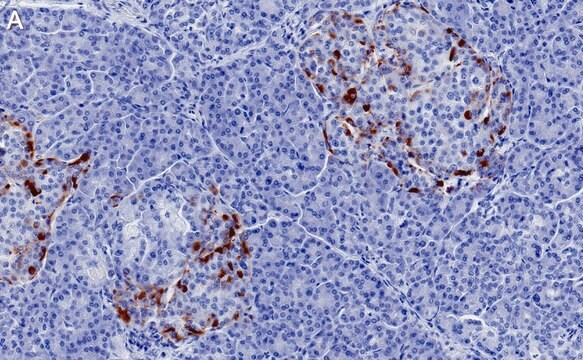ABN1727
Anti-CASZ1 Antibody
from guinea pig
Synonym(e):
Zinc finger protein castor homolog 1, Castor-related protein, CASZ1V1, CASZ1V2, Putative survival-related protein, Zinc finger protein 693
About This Item
Empfohlene Produkte
Biologische Quelle
guinea pig
Qualitätsniveau
Antikörperform
unpurified
Antikörper-Produkttyp
primary antibodies
Klon
polyclonal
Speziesreaktivität
mouse, human
Methode(n)
immunocytochemistry: suitable
immunofluorescence: suitable
immunoprecipitation (IP): suitable
western blot: suitable
NCBI-Hinterlegungsnummer
UniProt-Hinterlegungsnummer
Versandbedingung
ambient
Posttranslationale Modifikation Target
unmodified
Angaben zum Gen
human ... CASZ1(54897)
mouse ... Casz1(69743)
Allgemeine Beschreibung
Spezifität
Immunogen
Anwendung
Neurowissenschaft
Immunofluorescence Analysis: A 1:1,000 dilution from a representative lot detected CASZ1 immunoreactivity only among EYFP-negative cells, but not EYFP-positive Casz1-knockout cells by fluorescent immunohistochemistry staining of 4% paraformaldehyde-fixed retina cryosections from E17.5 transgenic mouse embryos carrying floxed Casz1 alleles and a ROSA26-floxed-stop::EYFP reporter allele, as well as Pax6 promoter-driven cre recombinase expression to allow tissue-specific (conditional) Casz1 knockout (Courtesy of Pierre Mattar, Christine Jolicoeur, and Michel Cayouette, Institut de recherches cliniques de Montreal (IRCM), Canada).
Immunoprecipitation Analysis: 5 µL from a representative lot immunoprecipitatd CASZ1 from 1 mg of mouse retina extract (Courtesy of Pierre Mattar, Christine Jolicoeur, and Michel Cayouette, Institut de recherches cliniques de Montreal (IRCM), Canada).
Western Blotting Analysis: A 1:1,000 dilution from a representative lot detected both CASZ1 spliced variants (CASZ1V1 and CASZ1V2) of either human or mouse origin in 20 µg of lysates from respective HEK293T transfectants (Courtesy of Pierre Mattar, Christine Jolicoeur, and Michel Cayouette, Institut de recherches cliniques de Montreal (IRCM), Canada).
Western Blotting Analysis: A 1:500 dilution from a representative lot detected a CASZ1 immunoreactive band in E17.5 mouse embryonic retina extract, but not in lysate from untransfected HEK293 cells (Courtesy of Pierre Mattar, Christine Jolicoeur, and Michel Cayouette, Institut de recherches cliniques de Montreal (IRCM), Canada).
Qualität
Western Blotting Analysis: A 1:5,000 dilution of this antiserum detected both CASZ1 spliced variants (CASZ1V1 and CASZ1V2) of either human or mouse origin in 10 µg of lysates from respective HEK293T transfectants.
Zielbeschreibung
Physikalische Form
Lagerung und Haltbarkeit
Handling Recommendations: Upon receipt and prior to removing the cap, centrifuge the vial and gently mix the solution. Aliquot into microcentrifuge tubes and store at -20°C. Avoid repeated freeze/thaw cycles, which may damage IgG and affect product performance.
Sonstige Hinweise
Haftungsausschluss
Sie haben nicht das passende Produkt gefunden?
Probieren Sie unser Produkt-Auswahlhilfe. aus.
Lagerklassenschlüssel
12 - Non Combustible Liquids
WGK
WGK 1
Flammpunkt (°F)
Not applicable
Flammpunkt (°C)
Not applicable
Analysenzertifikate (COA)
Suchen Sie nach Analysenzertifikate (COA), indem Sie die Lot-/Chargennummer des Produkts eingeben. Lot- und Chargennummern sind auf dem Produktetikett hinter den Wörtern ‘Lot’ oder ‘Batch’ (Lot oder Charge) zu finden.
Besitzen Sie dieses Produkt bereits?
In der Dokumentenbibliothek finden Sie die Dokumentation zu den Produkten, die Sie kürzlich erworben haben.
Unser Team von Wissenschaftlern verfügt über Erfahrung in allen Forschungsbereichen einschließlich Life Science, Materialwissenschaften, chemischer Synthese, Chromatographie, Analytik und vielen mehr..
Setzen Sie sich mit dem technischen Dienst in Verbindung.